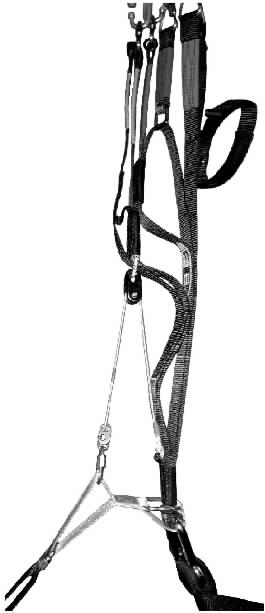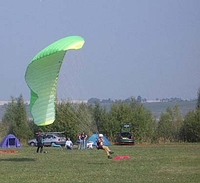Winching tips by Robo aka Lukas Barnard
This is for the less experienced winch pilots....on how to get a very
good get away rate from the winch.
1. The biggest mistake is releasing too early. Don't release under 150
meters. Even if its a 5 up. Wait until you are past the 150 meters above the
ground mark and then release in the next thermal
2. Release when your vario increase by more than 3 m/s....2 m/s on a weak
day. So if you are going up 2 up on the line constantly..
.then you will only release when its at least 4 up.
3. Release inside the thermal....even if its rough. If you wait until you
are outside in smooth air it will be hard to find the thermal again - if you
do this then fly straight downwind for at least 300 meters.
4. Look to see if the air is going up. Look for birds, leaves, black burn
stuff, grasshoppers or other gliders. If it goes up go for it. Its
especially good to winch in under a cloud and then release underneath it.
5. Release next to a trigger if you are not in a thermal or you think it may
be a thermal. Best not to release unless you are sure but if you have to
release...At Dunnottar its over the military camp or the mielie fields to
the east. In de aar its where the runways cross or at the wind pump.
6. The second biggest mistake - don't release when the vehicle is changing
direction. If the winch changes angle and goes more into wind your climb
rate will increase but its not a thermal. So if the winch change direction
its better just to ignore the increase in climb rate. If the vehicle takes
you right next past a trigger it could maybe be a thermal...just wait for
the car to drive straight for a few seconds to decide.
7. If the car goes downwind and the line becomes 'slap'....and you are
actually still climbing - its a thermal, release.
8. Whirlies are always a risk issue. Its best to launch just after a whirlie
has passed because they usually dont travel together.
9. You must be able to do a front start in absolutely no wind. zero wind,
nothing!
10. If you get heavy turbulance on the line and even a collapse - stay calm,
sort the collapse out - the winch will pull you through the
cr@p.
If you have a cravat (I get those on the Magus on the winch) - keep
direction and sort it out. This is usually because the pilot was not fast
enough to stop the collapse.
11. Don't scream at the winch driver, ever....even if she drags you
through the dust. Even if the whirlie picks you up and dump you and the line
is seriously tight.
12. After release dont be picky...work the light stuff...evenhalf ups...just
get up.
Hope this helps someone....Robo
Winching tips from Jon Pio ....
In a multiple towing environment like De Aar, the drivers tend to
incrementally
up the tension with each tow till a lighter person has a
nightmare tow.
INSIST on a tension that YOU are comfortable with and
mentally calibrate each
driver / winch to your OWN taste even if you are
new to winching, do not even
trust an instructors opinion on this, if
it feels too strong ask for
less tension next tow.
There is a tendency amongst newer winch users to
believe that more
tension is better. This is incorrect, more tension
simply results in a
very uncomfortable & more dangerous launch.
Often staying on tow an
extra 30 sec can compensate for 5kg of tension (thumb
suck).
The following factors all influence launch height & together
they have
more affect than tension, so why use high tension if % wise it
contributes
little to climb. ?
1/ Prevailing sink, in thermic conditions sink covers
about 4x more
area than lift so, launches in De Aar conditions will
invariably be in
sink. On same site, same day it is common to average
150m at midday &
450m at 18:00. Nothing will counteract the sink,
more tension just
makes the tow more unpleasant.
3/ Kite effect - the
rate of climb in the early part of the tow is
very dependant of the amount of
line paid out. You need to visualise
the force & tangental
directional of travel. It is quite common to fly
from sink with a low
line angle & lots of line into zero sink, in this
case it is common for
the pilot to experience >5m/s thinks it's a
thermal & releases into
zero sink.
3/ In my opinion 90% of people release too early, rather stay
online
use that kiting climb particularly if you are far behind the
bakkie. If
it is a thermal & you have lots of line out rather use the
kiting effect
tow thru the thermal & release AFTER the climb rate drops
then turn &
go back to the thermal, in many instances you will go back
into that thermal
HIGHER than when you flew thru it on tow !! Which will
be much higher than
the guy who released at the first strike.
4/ Time - PG's take time not
tension to climb, stay on tow as long
as possible. You need to figure
out if the thermals are starting low or
high by watching others. If
no-one is getting away from low releases
but they are getting plenty of zero
sink then you need to be higher
before the thermals will take you, even if
you see 7 up in that zero
sink.
When to use brake or Bar ?
--------------------------
I
used to believe in using 15% brake at all times however I now
sometimes us a
little bar. You can experiment at any time on tow. Use
of bar
increases the kiting effect by increasing your speeds up vector.
Use of brake
decreases your sink rate. So this indicates the following:
Use Bar
in a kiting situation i.e.. Low line angle , far behind bakkie
lots of line
AND the bakkie has lots of runway left.
Use brake when the bakkie is
beneath your feet, as the kiting effect is
now diminished, this will also
slow things down & draw more line from
the winch.
In both cases
EXPERIMENT & listen to your vario.
**Note the speed bar attachments
pull more bar as the line pulls more
down in relation to the harness.
This is good for stall avoidance but
the opposite of my speedbar logic here.
My
optimum tow pattern is:
100m of line at launch, pilot goes on 15% brake
as soon as he feels the
wing is flying normally & perpendicular to the
line. This provides more
collapse stability & control below 50m
& draws more line from the winch.
(****Note steer negatively, do not pull
more brake to turn !) The driver
meanwhile accelerates & pays out lots of
line, if the PG is still low
when 250m is out he slows down to just
keeping the drum turning. If PG
is high, driver speeds up even if drum
is paying out fast. The driver
should be attempting to time it so that
he gets to the end of the runway
with all his line out.
Using a tow assist to avoid parachutal
| With winching becoming more popular SAHPA has seen a
growing number of Paragliders going Parachutal during winch launch.
After a recent accident SAHPA consulted with DHV who also have
experienced this trend.
DHV recommends to apply a Towing Support for Paragliders to avoid
Parachutal Stalls during winch launch.
Here is an example what a towing support looks like.

SAHPA recommends that Paraglider pilots who intend to winch launch ,
contact their equipment supplier on advice of attaching a towing support to
their paraglider. |
Other References
Winch and XC
tips by Muechmeier DHV Info 122 http://stpxml.sourceforge.net/skygod/Airmanship/xc.html
And a Powerpoint presentation used for club
meeting workshop on XC
From OZ Report, http://ozreport.com/9.228
Canadian Towing Manual
A compilation of all the best, safest, and most effective information
about all methods of towing hang gliders and paragliders.
http://www.hpac.ca/pub/?pid=55
Laura's Payout Winch Operator Manual
or as MS Word doc
http://hpac.ca/tow/HPAC_Tow_Manual.asp
Going into lockout


